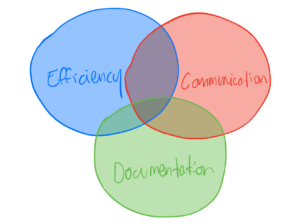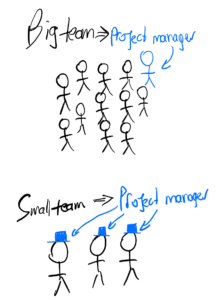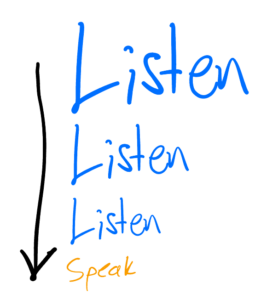Intro
Project management is a fundamental component of our success. Keeping things in order makes us successful, especially when there’s a lot of concurrent work. – Daniele Fusi
Project management is a vast topic. It’s an ever-developing field where people are building entire careers. There are countless tools, frameworks, and methodologies that you could use.
Therefore, it’s impossible to prescribe the optimal process to anyone – that’s something you must figure out for yourself.
Good thing we’re here to help.
Our approach is constantly changing – the process we outline in this blog post is slightly different from what we were doing six months ago and very different from what we were doing when we first started five years ago – and it’ll be even more different five years from now.
That’s okay.
We’re okay with this because we’ve got a guiding ethos that allows our tools and tactics to be fluid and dynamic while staying true to the process and approach we know works.
This series of blog posts will explore the tools and tactics we use to execute our projects and the philosophy we approach project management with. The blog post will be a series split into two separate parts, with a separate one covering each of the following:
- The philosophy we use to think about our project management and how you might start thinking more intentionally about your own optimal approach.
- The specific tools and tactics we use to execute our projects.
This blog post is the first in the series, all about our philosophy and approach. It’s broken down into the following sections, where each one is a major pillar of our project management system.
- Efficiency
- Documentation
- Communication

This blog post will explore these three concepts: what they mean to us, how we think about them, and how you might consider how they fit into your project management system.
At the end of each part is a section called “Food for thought.” This section contains a list of questions you could ask yourself to prompt thoughts about your project management system.
Efficiency

This is easily the most crucial principle of our project management approach.
When working with a small team (limited resources), you must make the most of everything you’ve got.
Because we don’t have the luxury of a project manager, their role is a responsibility the whole team shares.

It’s important to note this isn’t the result of disorganization but rather a byproduct of optimizing a team for leanness.
That same leanness allows us to move fast and iterate rapidly – a massive contributor to our flow and success.
We have optimized for this by hiring intentionally and nurturing the necessary skills in our team: self–sufficiency, organization, and collaboration.
Make project management so easy even an individual contributor can do it.
At first, we thought this would hold us back. We’ve since realized that it’s elevated everyone’s efficiency, and thus, the quality of our work has improved because of it.
Food for thought – how can you optimize for efficiency within your team:
- Do you ever feel you could have done one or two fewer builds, shipping faster and cheaper? What made the project so inefficient?
- Have you ever got to the end of a day where you felt super busy but can’t point to any work you got done? Meetings all day?
- Have you ever had your whole morning derailed by one single 10 am meeting that split the morning in half?
Communication

Seamless communication is critical to any process, especially when your work spans multiple time zones and continents.
This is why we’ve invested so much time into learning Chinese.
If there’s one thing you take away from this post, it should be this: everything relies on communication.
So many of the fancy tools and apps available today are just communication enhancers – they break down barriers to make collaboration and communication faster, easier, and smoother.
Food for thought:
- When was the last time someone more junior than you gave you honest feedback? How did you take it?
- Did you ever communicate something to your supplier in Asia, got a yes, then realized the week after there was a misunderstanding?
- Have you ever felt like everything was a top priority?
Documentation

What’s not documented, didn’t happen.
Say what you do, do what you say.
We’ve got notes for meetings from when the company first started. They’re meticulously organized and tagged so we can find them on demand.
We recently put those notes to use when one of our interns implemented a new CRM for sales and outreach management. Andrea and Daniele don’t have a sales background and won’t know how to use a CRM tool without a detailed procedure.
Here’s a little story from our founder and CEO, Daniele Fusi, to add some weight to this point:
“15 years ago, I got my first job in the US. I furiously wrote down everything I did, even if it was a makeshift document and I didn’t know what I was doing. Much of it was even in Italian because my English was pretty bad. Years later, I met with people who picked up my work, and they were so thankful for my notes. They even went through the trouble of translating my hand-written gibberish into English so they could understand what I accomplished.”
Often, we took notes in a brainstorming session without a clear purpose. Over and over, those notes have proved invaluable at a later date.
Realizing the immense benefits that previous documentation has brought our company, it’s a massive priority for us in the future and is baked into our project management process.
Food for thought:
-
- When was the last time you got to the end of a meeting, and you were still unclear what was the purpose of the meeting?
- Were you ever in a meeting where people disagreed on past commitments? What happened then?
- When was the last time your role in a project was ambiguous?
Conclusion
In conclusion, managing projects in a small company requires a tailored approach that prioritizes efficiency, communication, and documentation. These three guiding principles have been instrumental in our success and have allowed us to thrive in a competitive environment.
Efficiency is paramount in a small team where resources are limited. By distributing project management responsibilities among team members, we optimize for leanness and agility. Each team member becomes a capable project manager in their own right, contributing to our overall productivity and success.
Communication is the lifeblood of any project. We’ve invested time and effort into seamless communication, recognizing it as a cornerstone of our work philosophy. Transparent sharing, visual aids, and open collaboration are critical components of our communication strategy, ensuring everyone is informed and aligned.
Documentation is the foundation of accountability and knowledge retention. We maintain clear, organized records of meetings and discussions, allowing team-wide access for reference.
In the ever-evolving landscape of project management, it’s important to remember that there is no one-size-fits-all solution. Our approach has evolved over the years, adapting to the needs of our team and the demands of our projects. The key is to have a guiding ethos that allows for flexibility and growth while staying true to what works.
Consider some of the “Food for thought” questions – are there any growth opportunities?

